Fault Code 66: Gen1 ECA Battery Voltage
J1587: MID 130 PID 34 FMI 3, 4
J1939: SA 3 SPN 520271 FMI 3, 4
Overview
The UltraShift PLUS transmission is equipped with an Electric Clutch Actuator (ECA) that controls the position of the clutch assembly. The ECA operates on a non-switched battery power supply. Fault Code 66 indicates battery power to the ECA is outside of the acceptable ECA operating range.
Detection
ECA monitors the battery voltage supply it receives. If the supplied voltage falls below operating range or spikes significantly above operating range, the ECA will broadcast a fault condition to the TECU, which sets the fault code Active.
Conditions to Set Fault Code Active
FMI 3 – Voltage Above Normal or Shorted High: ECA battery voltage rises above 34 volts for 2 seconds or longer.
FMI 4 – Voltage Below Normal or Shorted Low: ECA battery voltage falls below 8.5 volts for 2 seconds or longer and the TECU has not detected low or weak battery voltage.
Fallback
All FMIs
- “F” flashes in gear display.
- Service light flashes (if equipped).
- Engine does crank and/or start.
- Transmission does not engage a gear from neutral.
- When the transmission is in gear, it will not allow up shifts.
- ECA may maintain the current clutch position using the clutch holding device.
- ECA may move the clutch to the closed position (clutch engaged against engine flywheel).
Conditions to Set Fault Code Inactive
FMI 3: ECA battery voltage drops below 32 volts for 6 seconds.
FMI 4: ECA battery voltage rises above 9 volts on 12-volt chassis or above 18 volts on 24-volt chassis for 6 seconds.
Possible Causes
FMI 3
- Starting/Charging System
- Alternator/Generator failure
- Improper vehicle jump-start
FMI 4
- ECA Vehicle Harness
- Damaged wiring between the vehicle batteries and 3-Way ECA Connector
- Bent, spread, corroded or loose terminals
- Wiring shorted to ground, shorted to power or open
- ECA 40-amp Fuse
- Bent, spread, corroded or loose fuse terminals
- Fuse not properly seated or connected
- Vehicle Batteries
- Internal failure
- Starting/Charging System
- Alternator/Generator failure
- ECA
- Internal failure
Component Identification
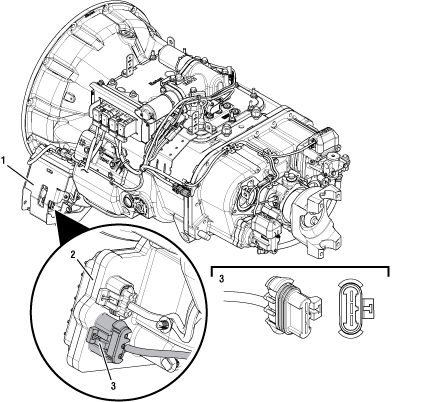 |
1. Gen1 ECA Shield 2. Gen1 Electronic Clutch Actuator (ECA) 3. 3-Way Gen1 ECA Connector |
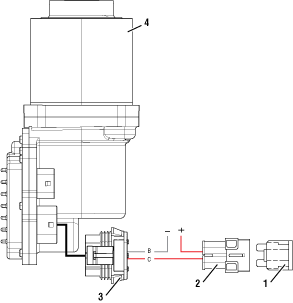 |
1. 40-amp Fuse 2. In-line Fuse Holder 3. 3-Way Gen1 ECA Connector 4. Gen1 Electronic Clutch Actuator (ECA) |
 |
Fault Code 66 Troubleshooting Gen1 ECA
Inspect ECA OEM Power Supply Connector, reference image below.

If equipped with a Gen1 ECA, Go to Step B
If equipped with a Gen2 ECA, go to Fault Code 66: Gen2 ECA Battery Voltage.
Record the transmission fault codes, FMIs, occurrences, and timestamps from the Service Activity Report created during the Diagnostic Procedure.
If Fault Code 66 is Inactive and there are other Active fault codes, troubleshoot all Active fault codes.
If Fault Code 66 is Active, Go to Step C
If Fault Code 66 is Inactive, Go to Step D
Key off.
NoticeSet parking brake and chock wheels.
Key on with engine off.
Connect ServiceRanger.
Retrieve and record the transmission fault codes and FMIs, and their occurrences and timestamps.
Note: Low battery voltage or jump starting the vehicle can induce Fault Code 66.
If Fault Code 66 remains Active, Go to Step E
If Fault Code 66 changed to Inactive, Go to Step D
Set parking brake and chock wheels.
Place transmission in PD Mode. See more about Product Diagnostic (PD) Mode
Note: Transmission does not enter PD Mode when Active fault codes exist.

Wiggle wiring and connections of ECA Power Supply Harness between batteries and 3-Way ECA Connector. Look for signs of pinched or chafed wiring. Verify all connections are clean and tight.
Exit PD Mode by powering down.
Notice
If any fault sets Active while wiggling the ECA Power Supply Harness, refer to OEM guidelines for repair or replacement. Go to Step V
If no fault sets Active while wiggling the ECA Power Supply Harness, Go to Step E
Key off.
Load test each vehicle battery per OEM specifications. Record reading(s).
If any battery does not pass the Load Test, refer to OEM guidelines for repair or replacement of batteries. Go to Step V
If all batteries pass the Load Test, Go to Step F
| Battery | Voltage Drop | Load Test Status (Pass/Fail) |
|---|---|---|
| 1 | ||
| 2 | ||
| 3 | ||
| 4 | ||
| 5 |
Key off.
Inspect the ECA Power Supply Harness between the batteries and the ECA for signs of rubbing or chafing to the wiring.
Inspect the ECA 40-amp In-line Fusible Link or Fuse Holder Con-nections for damage and bent, spread, corroded or loose terminals.
Note: Some chassis use a power and ground distri-bution block separate from the battery or may route power and ground to the starter. Be sure to clean and inspect connections at this location and at the battery.
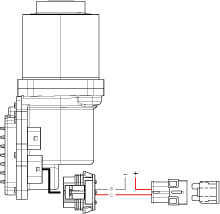
If damage to the ECA Power Supply Harness is found, refer to OEM guidelines for repair or replacement. Go to Step V
If no damage is found, Go to Step G
Key off.
Disconnect 3-Way ECA Connector.
Verify connector is free from any corrosion; the ter-minals are not bent, spread or loose; and there is no damage to the connector body.
Confirm the 3-Way ECA Connector has a seal plug in Cavity A.
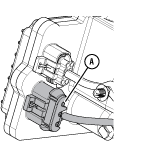
Inspect ECA side of 3-Way ECA Connector, verify connector is free from any corrosion, the terminals are not bent, spread or loose; and there is no damage to the connector body.
If damage to the 3-Way ECA Connector is found and/or missing seal plug in Cavity A, refer to OEM guidelines for repair or replace-ment. Go to Step V
If damage to the ECA side of 3-Way ECA Connector is found, replace Electronic Clutch Actuator (ECA). Go to Step V
If no damage is found, Go to Step H
Key off.
Measure voltage between 3-Way ECA Connector Pin C (Battery positive) and Pin B (Battery negative). Record reading(s) in table.
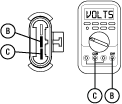
Compare reading(s) in table.
If readings are out of range, refer to OEM guidelines for repair or replacement of the ECA Power Supply Harness. Go to Step V
If readings are in range, Go to Step I
| Pins | Range | Reading(s) |
|---|---|---|
| C to B | Within 1.2 V of Battery Positive (+) |
Key off.
Measure voltage between 3-Way ECA Connector Pin C (Battery positive) and ground. Record reading(s) in table.

Compare reading(s) in table.
If readings are out of range, Pin C (Battery positive) and Pin B (Battery negative) wires are incorrectly pinned in the ECA 3-Way Connector. Refer to OEM requirements for repair or replacement. Go to Step V
If readings are in range, Go to Step J
| Pins | Range | Reading(s) |
|---|---|---|
| C to Ground | Within 1.2 V of Battery Positive (+) |
Key off.
Load test the 3-Way ECA Connector and ECA Power Supply Harness with an external load source. Use a sealed beam headlamp or blower motor attached to Pin C (Battery positive) and Pin B (Battery negative). Load Test for 5 minutes to verify the harness will carry a load with the 40-amp fuse or fusible link installed.

Wiggle the ECA Power Supply Harness during the Load Test from the vehicle batteries to ECA.
If the ECA Power Supply Harness does not carry a load, refer to OEM guidelines for repair or replacement. Go to Step V
If the ECA Power Supply Harness carries a load and no fault was found with the ECA Power Supply Harness or battery/charging system, replace the Electronic Clutch Actuator (ECA). Go to Step V
Key off.
Reconnect all connectors and verify that all components are properly installed.
Key on with engine off.
Clear fault codes using ServiceRanger.
Drive vehicle and attempt to reset the code or duplicate the previous complaint.
Check for fault codes using ServiceRanger.
If no fault codes set and the vehicle operates properly, test complete.
If Fault Code 66 sets Active during the test drive, Go to Step A
If a fault code other than 66 sets, troubleshoot per Fault Code Isolation Procedure Index.